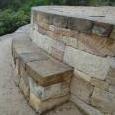Leaderboard
Popular Content
Showing content with the highest reputation on 01/15/19 in all areas
-
Just had the air test done and we achieved 0.6ach. This is with a temp front door albeit sealed as best we could and the Internorm sliding doors leaking like a sieve. We have one large set that did not leak at all and the two sliders joined together where atrocious. We are obviously very pleased with this result and hope to improve on that as we need to do another one at the end.8 points
-
Our design calls for some pocket doors - 6 in total - good for space saving, should look tidy. We decided to go with Eclisse and got them from the ever helpful Alan at Door Supplies Online. We will also get our door sets from him, to match, and he'll supply some matching architrave to finish the pocket doors nicely. Will post photos of the finished doors when we get there (probably September). In the meantime, we needed to install the pocket frames in advance of plaster boarding. It seemed too easy. But I am posting this because we had slight issues understanding how they fitted so hopefully this post will help someone else in the future. Him indoors built them so quickly I didn't even get photos of him putting them together. But he assures me that the instructions were straightforward to follow and they went together well. Top tip - don't throw out the bits of polystyrene that look like packaging. They actually help give it some bracing strength when lifting the whole thing into place (otherwise it bends quite a bit). The You Tube videos are also helpful. Our MBC structural openings were exact (to the mm) so we had allowed a bit too much structural opening (we didn't know how mm perfect they would be). We then had to pack slightly off the stud frame (offcuts of egger board and OSB). And also pack off the floor to ensure the door was fitted at finished floor level. Have allowed 20mm for carpet / underlay upstairs (and tiles to the bathrooms) so should be OK. The frames come in 100mm finished wall depth or 125mm finished wall depth. With 89mm stud walls this does give a bit of a conundrum, assuming 12.5mm plasterboard. We chose 125mm. And then Alan suggested putting ply on the frame as well to make it extra rigid. Also useful for subsequent hanging of pictures / toilet roll holders on finished wall - otherwise fixings might go through and result in scratching the sliding door. What we couldn't understand was that the pocket side of the door had a frame that was 125mm wide. But the bit the door closes on was only 100mm wide. For a short while I doubted the assembling ability of my definitely better half. Thankfully, a call to Alan set that straight. Though I am not sure I have been forgiven yet. There is a timber jamb (125mm wide) that fits over the 100mm section, making the whole thing 125mm wide. Now for the ply. It has been a bit of a juggle. Some need ply and some don't, some need double ply before plasterboard on one side to build out the stud work. And we need to match the ply on each side otherwise the door will be off centre in the total wall depth. Feels like overkill and probably is. But it will be solid! The ply attaches to the door frame itself using little screws (supplied by Eclisse). If you don't put ply on then these little screws fix the plasterboard. This door below has ply on the left hand side to bring the stud wall out to the frame edge. Then it will have ply over the top of that (and the frame) to match the other side. Then plasterboard. Toilet roll holder going on the other side and mirror on this side so will be strong enough for those. From the inside of the en-suite it looks like this, with one layer of ply. So, just plasterboard over the top of this. All the standard (classic) pockets are now fitted. Ply to go on the other 4 still so plenty of late nights in store before the plasterboarders come in. We are rather enjoying this bit though. Allows us to actually contribute to our build in a meaningful way, saves some cash, justifies the circular saw Christmas gift...... The telescopic pocket door is being saved for another day.4 points
-
That's alot of insulation - over 600 bags of the stuff. They cut a load of holes in the MBC vapour layer ply. More holes than we ever imagined. Then they pump the insulation into the holes to fill up the walls (300mm deep) and ceilings (400mm deep). Some of it escapes. Easy to vacuum up though. Then they put the ply discs back in and tape over the holes. They have left us with some patches for areas of the ceiling they can't reach and for any they might have missed. Only found one so far. Sean and his firm - works subcontracted for MBC for alot of the pumped cellulose insulation for them - was fantastic. The house is definitely warmer inside now, and the echo is now deadened. It is so quiet in there. Can't wait to move in........3 points
-
After reading every post on this forum on the subject of sound insulation and in particular Rockwool I wanted to document our experience. Until the delivery arrived and we opened the packets we really didn't know what we were going to be working with. Here is the best description I can give. We ordered the following from Insulation4Less. They told us the lead time was about 4-6 weeks (nationwide shortage) but actually it all came within a week leaving us with a literal mountain of rockwool to store around site. It was wrapped but needed to be lugged into the house out of the rain. Big job. The 50mm deep packs were orginally intended to go in the ceilings where there were lots of pipes to fit around. We chose RWA45 rather than the more expensive Flexi. Having not seen the Flexi I can't give a really accurate comparison. But the RWA45 is flexible and can be pushed into spaces and compressed a little anyway. And it is cheaper. It is not rigid / solid like Celotex (which I had first thought it might be). Here are some open packs. It is pretty easy to cut using an insulation saw like this. https://www.screwfix.com/p/bahco-insulation-saw-22-560mm/7498k But it does shred easily too. Mask and gloves absolutely essential. The 100mm deep stuff looks like this. So although it comes in these "batts" which have a form to them, you can trim to to the size you need. We are trimming almost everything because the 600mm wide batts don't fit into the 560mm gaps between the 600mm centred studs. But there are plenty of places to stuff the offcuts and the puzzle of how to use every offcut as efficiently as possible is keeping us both amused somewhat. We are fitting this into all the stud walls (internal) and the ground floor ceiling. No need for any insulation on the external walls or top floor ceilings as that has been pumped in by MBC (more of that in another blog). Hubby used our MVHR builders straps to fit up a load in the ceiling. He is now using cheap pallet strapping and a staple gun! It is fair to say that we have been doing this sound insulation on and off now for well over a month. It is a big job. Ceilings harder than the walls. Time consuming. A bit (alot) messy. Requires us to ply the walls first (where ply is needed) and then insulate. For the stud walls that don't need ply we will work as quick as we can in the evenings once the the plasterboarders are on site (due next week) filling in behind them as they plasterboard one side. Going to be a busy week. But progress is satisfying and physically working on our build again is fun.2 points
-
At the same time that all the indoors first fix was going on during December, there was plenty going on outside, too. From the perspective of the build, the main event was the slate cladding but the thing that drew by far the most attention was the digging of the pond. I use the term 'pond' loosely, and it has been the subject of great debate, but it is a wildlife pond. Not a swimming pond, not a boating lake, nor a flight pond, which are all alternative suggestions that have been made. It will be a wildlife pond. Let's begin with the simplest thing - a old inspection whiteboard from work and a permanent marker meant that I finally got a sign up to stop all our delivery drivers carrying on down the lane and annoying the farmer. During the design stage, the architect was very keen for us to have the super-trendy (around Dorset, anyway) burnt larch effect cladding, but we really didn't like it at all. Not the colour, but the overall effect, and so when we saw a house with slate hung vertically as a type of cladding, we decided that was the one for us. I persuaded our roofer, Dylan Faber, that this would be a really good job for him to undertake and add another string to his bow. We had originally intended to use Marley vertigo slates, which are designed to be used for that purpose, but it turned out that they aren't used much in the UK and would have to be made to order in France and then shipped over, giving a lead time of somewhere in the region of 8 to 10 weeks. Instead, we used the same slates as are on the roof, but with the Marley trims and accessories, and it all worked out well, particularly as the slates were slightly cheaper than the Marley ones. The brand is SVK. The process is exactly the same as for the main roof - membrane, batten and counterbatten with the slight variation of using copper rivets rather than the hooks that were used on the roof and they're nasty scratchy things that you don't want to lean up against. Here's the first stage of the prep work: Once all the counter batten was up, the slating could start. The team started at the front as this is the most weather exposed area and I was keen to get some protection on it and make the building more water tight. A little later that day: Other than the stairwell section, the whole of the upper floor of the house is now clad with the slate, and a fine bit of work it is. Dylan Faber and team have been a pleasure to work with and I would gladly use them again. The stairwell section will be clad with the stone slip Tier system that's going to cover the ground floor. This gives a nice break to the slate and reduces the visual impact of the upstairs, and this work should be getting underway at the start of February. It's a little later than I had planned, but that's largely due to the lead time to get the materials in as the supplier has stock of every colour apart from the one we're having. Besides the slate and the stone slip, one of the more dramatic features outside is the brise soleil that sits in front of the stairwell window. This is a vertical run of horizontal cedar fins that are held in position on a RAL coated steel frame. The brackets and coach bolts that hold the frame and fins in place had to be done as a first fix item and before the cellulose was blown in. There are 3 sets of brackets, top, middle and bottom, and it's the top and middle ones that take the majority of the weight of the entire structure. The MBC timber frame construction means that there is nothing behind the outer boards and so the positions for the brackets had to be packed out before installation. This meant cutting out a section of the airtight board on the inside, attaching some nice sturdy noggins to the external wall from the inside, then re-sealing the cut out. Clearly, trying to do this once the cellulose had been blown in would be more than tricky. Once packed, the guys from Contrasol Ltd, who are supplying the system came along and first fixed the brackets. Here are the top ones: And here are the centre ones: In due course, once the cladding is complete, the framework will be attached to the brackets and the timber fins fitted. Contrasol have been a really good firm to deal with and the standard of how they approach things has been very professional. Besides working out all the loads for the framework, etc., they also calculate the optimum angles for the fins and the fins themselves are engineered and precision cut. The fins are actually manufactured by Vincent Timber Ltd in Birmingham, and they are things of beauty in their own right. Here are the fins carefully stacked up just after delivery: And here's a close-up of them: Besides the house itself, we've intended from the outset that the garden and field were every bit as important a feature and fundamental to this is the wildlife pond. One could ask what else we would do with such a large plot otherwise, but this has allowed OH to realise a long-held ambition of having what we hope will develop into a fabulous haven for wildlife. Given that, there seemed little point in limiting our ambition at the start so our groundworkers, Keith and Gail, got digging. This started off with me using a couple of cans of line marker paint to give the outline and then Keith scraping off the turf. Next up was scraping off the topsoil so that we could retain that for later use. Here's the outline of the pond, as seen from the scaffolding. Keith had just started digging out the deeper part of the pond when the tracks came off the digger - the first of many times that day. That will teach me to try and save money by hiring kit from the local farmer. This is what he had to contend with multiple times: We finally got there over the course of a few days, and here's the pond with the deeper centre dug out, prior to having these scraped a bit more and given gradients rather than steps. Once things were smoothed off a bit, this is how it ended up. The water you can see coming in is from a land drain that we broke through, which we will leave broken as it's as good a source as any to fill it up. Our attempts to block the other end of the land drain haven't worked so we need to give this another go in due course as we'd really like the water to stay in the pond. Finally, this is to prove that I'm an equal opportunities employer and that ladies can do groundwork as well. And because Gail felt very neglected about not being pictured on the blog when she and Keith have done so much work on the site. This one's for you, Gail! Keith's other act of vandalism work that week was to give the old electricity pole a good shove and get it out of the way once and for all. Most satisfying. Next up on the blog will be more inside work involving vast amounts of plasterboard and rockwool, but that's for another evening. TTFN2 points
-
Oh, and maybe this bit of info will be of morale benefit in your hour of need :- If this was a retail bathroom, and I was charging for everything you have done to date, the price would be north of £20k. That's a lot of the weird shit you've drunk since this began. ?1 point
-
1 point
-
Currently having this argument retrospectively with my ground investigation firm as their site work was invasive (digging holes etc) vs a simple walk over study. However there is an element of research and report writing which would be eligible for VAT. They're saying that never in 27 years have they zero rated any services but I keep plugging away and sending them the relevant examples like above. Unlikely to get the VAT (or part of) back but will keep bashing away as it costs me nothing1 point
-
1 point
-
Mine was called a hanger plate, just to complicate things. Was fitted to timber frame though, not ICF1 point
-
The warranty providers won't care who or when it was built. The only bits that matter are the how long and how much. If they are doing it in the evenings and weekends and their work is acceptable and you are happy with that method then all is good.1 point
-
This bit of the Building Regs is nonsense. All that needs to be done is a letter from you stating "Notice under regulation 37 that water consumption is less than 125 litres/person/day using fittings approach”. Spend no more time on this!1 point
-
A recent survey we did External measurements Width: 2550mm Height: 2110mm Internal measurements Width: 2520mm Height: 2065mm Order Size: Width: 2530mm Height: 2100mm This was achieved by measuring external size in 3 places and using the smallest, repeated inside and then deducting 10mm from the external measurements. Always measure from underneath the external sill.1 point
-
This is just "politically correct" nonsense. So you want to fill the kitchen sink with water to do your washing up. What will a flow restrictor do to "save water"? It will just irritate you as it takes longer to fill the bowl.1 point
-
Makita 2012NB/2 Thicknesser, 220 V, 1650 W, 304 mm https://www.amazon.co.uk/Makita-2012NB-Thicknesser-220-1650/dp/B000051ZOO i have had this one for over a year and it’s been fantastic, have put 300mm wide dry oak through it without a problem, I did a lot of research before buying this one, minimal snipe and good power, would buy again.1 point
-
Builders looked. Not an issue. Only problem is as it's quite long and skinny could 'wobble'. So as a 'lets try it and see' solution could potentially add a chrome bar floor to ceiling at far end for definite strength.1 point
-
I remember our basement looking like that - wan't much point clearing it until the rest of the house was watertight. At the end it resembled the trash compactor from Star Wars...1 point
-
You can see where I chipped off the render at the sides to get the width: Then the drawing I gave to the guy who fab'd the window: Wedging and foaming: As ever, helped at every step of the way by the good folk on here! Homemade wedges were invaluable. Rather than expanding foam I'd use Compriband next time as I did on the second window I did.1 point
-
I think 3.3.6 is more about HMRC trying to close loopholes that allowed people to zero rate work on a "plot" and then never build the house or on work done after completion. "Design" services are standard rated as per 3.4.1. So if a civil engineer designs a retaining wall then it would be standard rated. I think if you hired a civil engineer to "design and build" a retaining wall as a package then the lot that would be zero rated to you.1 point
-
IMO really work at it and you can save enough on materials to cover quite a lot of specialist Labour. Obvs it depends what you compare it with, but I think that 25-35% is possible as an average. I tend to use Wickes retail prices as a benchmark. F1 point
-
Yep, insulation and PV are amongst the few index-linked pensions available to most of us.1 point
-
elu, better than dewalt, (bought out and copied them) https://www.ebay.co.uk/itm/Elu-EPT-Planer-Thicknesser/143085570770?hash=item2150908ad2:g:8z8AAOSwgbdcNlBH:rk:1:pf:1&frcectupt=true1 point
-
As far been said many times in here...You only pay for insulation ONCE! As in put enough in & do it right and it'll serve you well and as fuel costs double, triple, quadruple the impact will affect you less.1 point
-
Who wouldn't want to live in the Cotswolds, it's beautiful as a whole. I'm there fairly rarely but i never get angry when I am. Even shopping at Tesco is a pleasure there...1 point
-
wait till you get to my age you just a boy 67 and starting to do a build this year --.LOL must be nuts!!1 point
-
Most folk just quickly learn how long it takes to heat up, and use a simple conventional programmer to turn it on for instance 2 hours before you want it to be warm. At the other end of the day you can turn it off before you have finished as it takes a similar length of time to cool down. Why make things complicated? The few times I have seen a complicated controller, it is not being used because nobody can understand it.1 point
-
Is the point of ufh that you set up the times to suit how you live and then just forget about it. That's how I work mine. You already have a system that I presume works so why do you need another costly unit to learn how long your floor takes to heat up. I have a similar unit at home called my wife. She knows how long it takes for heat to come through and feel it on her feet so my times are set by that and the morning alarm to waken the kids. To be fair one of the heat learning type units would have been much much cheaper than her.1 point
-
@nmpnmp Mine work through a Neo Hub which I can programme and run from an app. I can also use wall stat if I choose. No-one has ever told me they would learn the temps but as no one told me much I have had to work it out for myself so who knows. My stats are NeoStat V2 looking at the instrctions there are a lot of features I have never explored.1 point
-
I have older Heatmisers room stats but they don’t have this feature although the one who remembers how long a room takes to heat up is me so I set the on time accordingly ?. They work pretty well. @PeterW may be your man for this question. @lizzie has a newer system. Does yours have this feature @lizzie?1 point
-
Found a leak the other day and started to think what have I missed and that the render may have to come off to rectify. Upon further investigation it looks like the sealant that is used to seal the glass units in place has failed and is allowing water to get behind the aluclad exterior frame (I hope). So only another fault with our Internorm installation which is definitely the installation teams fault.0 points











.thumb.jpg.bac90f3bbf6868cf2118d010d936c99d.jpg)
